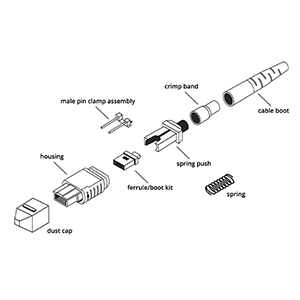Thank you very much for reading this article, I will introduce you to 10G SFP SR optical transceiver. As a key component in optical fiber communications, 10G SFP SR optical transceivers play an important role in achieving high-speed transmission and reliability. Understanding its characteristics and application scenarios will help you choose a suitable optical transceiver to meet your communication needs.
Introduction to 10G SFP SR optical transceiver
The 10G SFP SR optical transceiver is an optical module used for 10Gbps data transmission, using SFP (Small Form-Factor Pluggable) packaging. The following is an introduction to 10G SFP SR optical transceivers:
Definition and rationale:
The 10G SFP SR optical transceiver is a short-distance optical module. SR stands for “Short Reach”, which means it is suitable for short-distance optical fiber transmission. It is based on photoelectric conversion technology, which converts electrical signals into optical signals for transmission, and then converts the optical signals back into electrical signals.
The basic principles of the 10G SFP SR optical transceiver are as follows:
- Transmitter: The transmitter converts electrical signals into optical signals. The electrical signal is converted into an optical signal through an electro-optical converter and then transmitted through an optical fiber.
- Optical fiber transmission: Optical signals are transmitted through optical fibers, which usually use multimode optical fibers (MMF).
- Receiving end: After receiving the optical signal, the receiving end converts the optical signal into an electrical signal through an optical-to-electrical converter, and then performs further processing and transmission.
Features of 10G SFP SR optical transceiver
10G SFP SR optical transceiver has various features and advantages, making it widely applicable in fiber optic communications. Below is a discussion of its features and advantages:
-
Transmission rate: 10G SFP SR optical transceiver supports a data transmission rate of 10Gbps, provides high-bandwidth transmission capabilities, and adapts to the needs of modern high-speed data communication.
-
Transmission distance: 10G SFP SR optical transceiver is suitable for short-distance optical fiber transmission. Usually the transmission distance on multi-mode optical fiber (MMF) can reach about 300 meters (OM3 optical fiber) or about 400 meters (OM4 optical fiber). This makes it ideal for application scenarios such as data centers and enterprise networks.
-
Fiber type: 10G SFP SR optical transceiver usually uses multi-mode fiber (MMF) for transmission, and the commonly used fiber types are OM3 and OM4. These fiber types have larger core diameters and are able to accommodate multiple light modes, enabling high-speed data transmission over short distances.
-
Flexibility and pluggability: The 10G SFP SR optical transceiver adopts SFP packaging, has hot-swappable function, and can be easily installed in the optical module slot. This pluggability makes optical module replacement and upgrades simple, while also providing greater flexibility and scalability.
-
Reliability and stability: 10G SFP SR optical transceiver has undergone rigorous testing and verification, and has reliable performance and stable signal transmission. They usually have lower bit error rates and higher anti-interference capabilities, and can maintain signal quality and stability in complex communication environments.
Application fields of 10G SFP SR optical transceiver
10G SFP SR optical transceivers are widely used in multiple application fields. The following are some practical application cases and explain why 10G SFP SR optical transceivers are suitable for these scenarios and the benefits they bring:
Data center:
- Application cases: In data centers, 10G SFP SR optical transceivers are often used for interconnections between servers, storage devices and network equipment to support high-speed data transmission and communication requirements.
- Advantages and Benefits: 10G SFP SR optical transceivers provide high-bandwidth and low-latency transmission, enabling data centers to quickly transmit large amounts of data. Its short-distance transmission characteristics are suitable for connections within data centers, and the use of multimode fiber can reduce costs.
Enterprise network:
- Application cases: In enterprise networks, 10G SFP SR optical transceivers are often used to establish high-speed connections between floors, communications between branches, etc., to meet enterprise requirements for bandwidth and performance.
- Advantages and benefits: 10G SFP SR optical transceiver provides high-rate transmission and short-distance transmission capabilities, adapting to the demand for high-bandwidth connections in enterprise networks. Its flexibility and pluggability make it easy to replace and upgrade network equipment while maintaining reliability and stability.
Remote monitoring:
- Application cases: In remote monitoring systems, such as video surveillance, security and industrial automation, 10G SFP SR optical transceivers can be used to transmit high-definition video and large-capacity data.
- Advantages and benefits: 10G SFP SR optical transceiver enables the transmission of high-quality video and large-capacity data through optical fiber transmission while maintaining signal quality and stability. Its high-rate transmission and short-distance transmission characteristics are suitable for the needs of high-bandwidth and long-distance transmission in remote monitoring systems.
How to configure 10G SFP SR optical transceiver
Steps and key points for configuring 10G SFP SR optical transceiver:
-
Confirm equipment compatibility: Before purchasing and installing a 10G SFP SR optical transceiver, ensure that the equipment is compatible with and supports the specifications and interface types of the optical transceiver.
-
Physical connection: Insert the 10G SFP SR optical transceiver into the optical module slot, making sure it is inserted correctly and connected securely.
-
Fiber optic connection: Connect the optical transceiver to the fiber optic cable using an appropriate fiber optic connector. For 10G SFP SR optical transceivers, multimode fiber (MMF) is used for connection to ensure the quality and adaptability of the fiber.
-
Configure device parameters: Configure the device accordingly according to actual needs. This may involve the device’s network settings, speed settings, fiber type, etc.
-
Testing and verification: After the configuration is completed, test and verify to ensure the normal operation of the optical transceiver. Network testing equipment or tools can be used to check transmission quality and performance.
Please note that the above steps and precautions are for reference only, and specific configuration and usage requirements may vary depending on the device and manufacturer. Therefore, before proceeding with configuration and use, it is recommended to carefully read the device’s user manual and manufacturer’s guidelines and follow the specific instructions and recommendations provided by them.
Performance indicators of 10G SFP SR optical transceiver
Performance:
-
Transmission distance: The transmission distance of 10G SFP SR optical transceiver is usually up to 300 meters, which is a typical value when using standard multi-mode fiber (MMF). Transmission distance is also affected by fiber quality, connector quality and environmental conditions.
-
Fiber type: 10G SFP SR optical transceiver is suitable for multi-mode fiber (MMF). Commonly used fiber types include OM3 and OM4. These fiber types have high bandwidth and transmission performance and are suitable for 10Gbps data transmission.
-
Power budget: The 10G SFP SR optical transceiver will produce a certain amount of optical power attenuation during the transmission process. The power budget refers to the optical power loss that the system can tolerate under a given transmission distance and fiber type. The power output and receive sensitivity of the optical transceiver need to be within the power budget.
-
Operating temperature range: The operating temperature range of the 10G SFP SR optical transceiver refers to the temperature range that it can withstand during normal operation. Typically, they are capable of operating within a temperature range of 0°C to 70°C, but the specific operating temperature range may vary depending on the manufacturer and device model.
For specific applications and scenarios, you should also carefully read the specifications of the 10G SFP SR optical transceiver and the technical documentation provided by the manufacturer to understand more detailed performance indicators and limitations and ensure that it meets the specific requirements.
Conclusion:
10G SFP SR optical transceiver plays an important role in optical fiber communications. It features high-speed transmission, moderate transmission distance, and supported fiber types. Compared with other optical transceivers, 10G SFP SR optical transceivers have many advantages and are suitable for multiple application scenarios such as data centers and enterprise networks.
If you are interested in 10G SFP SR optical transceiver, please contact us. We will provide you with professional advice and support to help you choose the optical transceiver solution that suits your needs and achieve excellent communication performance and reliability.
10G SFP SR optical transceiver FAQ
The SFP-10G-SR is a type of SFP+ transceiver used for 10 Gigabit Ethernet (10GbE) data transmission over short-reach multimode fiber. It is commonly used for high-speed network connections in data centers, enterprise networks, and telecom operators.
Typically, there is no difference between SFP-10G-SR and SFP-10G-SR-S. The “-S” suffix is sometimes used by manufacturers to indicate that the transceiver complies with the MSA (Multi-Source Agreement) standard. The MSA standard ensures interoperability between SFP+ transceivers produced by different vendors.
10G SR SFP+ transceivers are designed for multimode fiber. It does not work with single-mode fiber.
SFP-10G-LR and SFP-10G-SR are two different types of SFP+ transceivers. SFP-10G-SR: suitable for short-distance multimode fiber (usually within 300 meters). SFP-10G-LR: Suitable for long distance single mode fiber (typically 10km+).
The SFP-10G SR SFP+ transceiver uses OM3 or OM4 multimode fiber. OM3 multimode fiber is suitable for transmission distances ≤ 300 meters. OM4 multimode fiber is suitable for longer transmission distances (typically up to 400 meters).
SFP+ SR transceivers are a type of small form-factor pluggable (SFP+) optical module designed for data transmission over 10 Gigabit Ethernet networks using multimode fiber.
No, SFP-10G-SR is not single-mode. It only works on multimode fiber.
No, the SFP-10G-SR transceiver is designed for use with multimode fiber and is not compatible with single-mode fiber. Using single-mode fiber may result in signal loss or performance degradation.
Yes, but you will need to use an SFP+ transceiver designed for single-mode fiber, such as the SFP-10G-LR. SFP-10G-LR can support longer transmission distances, typically over 10 kilometers.



